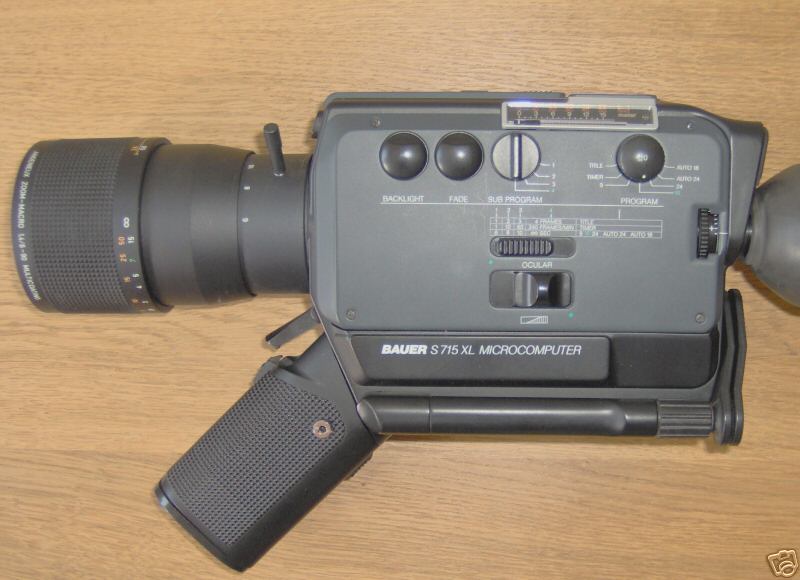Bauer S 715 XL Microcomputer
Bauer S 715 XL Microcomputer
Year: 1978-1982
Lens: Angenieux Macro 1,4 / 6 - 90 mm
Sound or silent cartridges
Auto / Manual Zoom with 2 Speeds
Split Image Focusing
Macro focusing
Manual / Auto Exposure
ASA range: 25/40 ASA or 100/160 ASA (filter/no filter)
Frame rates: 9, 18, 24, 40 + single frame
Shutter degree: 200
Backlight Control
Fades
Lap dissolve
Interval timer with 1/4-60 second intervals
Remote control socket
Flash contact
Weight: 2200 g
Auto / Manual Recording Level Control
6 X 1,5V batteries + No separate battery for light meter
Prices on eBay:
- UK:
- £ 77 in 05-06/2007
- Europe:
- EUR 92 in 05-06/2007
- EUR 95 in 05-06/2007
- EUR 72 in 05-06/2007
- Germany:
- EUR 60,53(+ EUR 7,00 shipping) in 09/2007
Comments[edit]
The top model of Bauer cameras. This camera is one of the last generation of Super 8 cameras, and accepts film speeds of ASA 40 or 160 only, neither of which are available nowadays. The camera lightmeter will not set exposure properly with the Kodak Ektachrome 64T film without manual adjustment (by default it overexposes by 2/3 stop), the instruction manual states that it only senses two ASA settings from cartridge notches. You should set exposure manually when using this film.
- Like every BAUER: According to test and info of the instruction manual it can only meter 40 and 160 ASA in artificial light with the corresponding 25 and 100 ASA in daylight.
- The original, unmodified camera can not run the Ektachrome 64T automatically.
Modifications (lightmeter, external battery) see: http://www.film.project-consultant.net
Here are instructions on how to adjust the sensitivity of the exposure meter: Bauer: how to adjust S715XL meter. Warning: if sensitivity is changed generally the 25/40/100/160 ASA films will be underexposed!
Reviews[edit]
By "audadvnc"[edit]
Super 8 Man called this "the Cadillac of cameras". The big deal with this camera is its lens; the Angenieux 6-90mm that was originally designed for the high end Beaulieu, but didn't make it to regular production as the lens was too expensive. The hype about this lens is valid: it takes very sharp pictures, even when wide open, a significant improvement over most Super 8 cameras. And of course it is a 15x zoom, which gives you plenty of reach on the telephoto end. The registration is steady, dependent of course on the condition of the S8 cartridge you use. The downside is its ASA 40/160 limitation; it needs an aftermarket modification to allow for lightmeter exposure sensitivity compensation, such as is found on the Nikon R8/10 cameras. It's a cheap and easy mod; about $2 in parts from Radio Shack and a half hour of time.
The camera has some computer driven timers which allow the shooter to get into the scene before the film starts rolling. Maybe it was useful in the home movie days, I've never used it.
It's a large camera with a big lens, and isn't very appropriate for inconspicuous handheld shooting. Bauer placed the tripod adapter way back by the eyepiece, a rather odd location. The frame and many internal parts are some precision moulded high-tech plastic, possibly polycarbonate, the sides are metal. Internally it's a complicated machine and isn't easy to work on. The original belts will go bad eventually, aren't available from Bauer anymore, and replacement requires strenuous efforts from the DYI technician. But if it's working properly, and you can set exposure to your needs, the S715XL is a very good camera indeed.
by Super8Scientist, 2016-2021[edit]
If you have the version that uses belts instead of gears (I THINK this is distinguishable by the words "S 700" on the battery compartment cap) it is an EXTREMELY quiet Super8 camera, second only imo to the Sound Nizo, of which I own a couple; When it runs it sounds like a cat purring. I would say one of these cameras in near mint condition or serviced like mine was will work fine for sync sound recording. I also have another one of these that I think uses gears. It doesn't work, so I haven't been able to compare the noise level of the two, but I imagine the belts are a lot quieter. One with gears is potentially easier to service though, so maybe that's a trade-off that's worth it. I wouldn't consider the camera's EE limitations a downside because using modern negative stocks, 1/3 - 1 stop over-exposure is something that can be easily fixed in color correction, or you can just have the film pulled 1 stop in development.
The lens is legitimately fantastic, very sharp, especially with a slow film stock the results are practically 16mm. I shot some wildlife footage in a national park, and even with a telephoto attachment on the lens, the sharpness was spot on.
eBay Auctions[edit]
